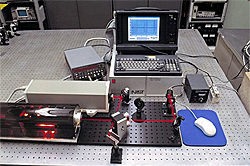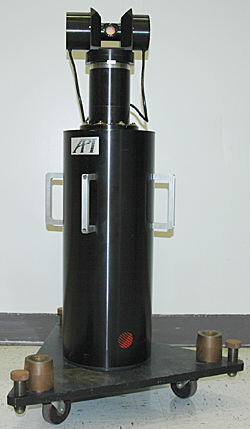Celebrating the 50th Anniversary of the Laser:
NIST’s Role in Laser Measurements and Applications
What is a laser?
Selected NIST Highlights:
Pre-1960
1960s
1970s
1980s
1990s
2000s
Laserfest home
1980s
 |
|
Iodine stablized helium neon laser.
Credit: NIST
|
1983—The meter was redefined by international agreement as the length of path traveled by light in a vacuum in 1/299,792,458th of a second. Length was now no longer an independent standard but rather was derived from the extremely accurate standard of time and a newly defined value for the speed of light. The improved definition was made possible by technology developed in the NIST labs of Ken Evenson and Don Jennings that allowed, for the first time, measurements of the very high frequency (number of oscillations per second) of visible laser light. NIST physicist Jan Hall measured the wavelength of an iodine-stabilized helium neon laser against the existing length standard—the wavelength of a Krypton discharge lamp—while Evenson and Jennings used their newly developed technology to measure the laser's frequency. The product of these two measurements (wavelength multiplied by frequency) yielded the value for the speed of light that was used for the new definition of the meter.
 |
|
Laser tracking interferometer.
Credit: NIST
|
1987—NIST scientist Kam Lau developed the first laser tracking interferometer combined with a servo system that allows the laser to track a moving target and measure the distance and angle of the target. These three-dimensional measuring systems have become essential for large-scale precision manufacturing, particularly in aerospace, where laser trackers have almost completely replaced traditional techniques for measuring and accurately assembling airplanes. Laser trackers are also widely used in the automotive, shipbuilding, machine tool, robotic, heavy industry, and energy sectors.
1988—After early achievements cooling and trapping neutral atoms with magnetic fields, NIST physicist William Phillips demonstrated that a gas of neutral sodium atoms could be cooled with lasers to 40 microKelvins, a temperature six times lower than previously thought possible. Phillips and his team made numerous pivotal contributions to laser cooling, including Zeeman slowing of atomic beams, magnetic trapping of laser-cooled atoms, and trapping of atoms in optical lattices. In recognition of this work, Phillips shared the 1997 Nobel Prize in physics with Steven Chu (now U.S. Secretary of Energy) and French physicist Claude Cohen-Tannoudji . http://physics.nist.gov/News/Nobel/1997nobel.html
 |
|
NIST physicist William Phillips
© Robert Rathe
|



